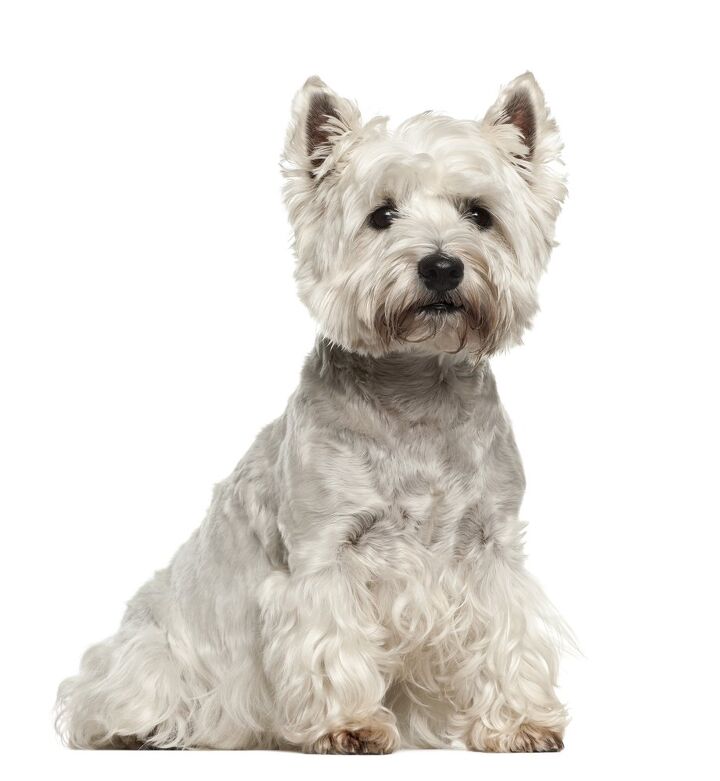West Highland White Terrier


About West Highland White Terrier
A robust and healthy terrier breed, the West Highland White Terrier is a favorite with dog lovers across the globe. Easily recognizable with its white mane and dark eyes, the West Highland White Terrier (also known as a “Westie”) will amaze you with its joyful, loving and devoted personality. This dog will make it clear from the get-go that it demands your attention and expects to be the center of your life. And how can you resist? Trust us, it’s impossible, just make it easy on yourself and give in to all of your Westie’s demands for attention.
The West Highland White Terrier is a busy dog that always seems to be into something. This means you can’t leave this pooch alone for too long, or else you’ll be coming back to some destroyed furniture or annoyed neighbors that have had to put up with marathon-length barking sessions. Will the West Highland White Terrier fit into your lifestyle? Read on to find out.
Easily recognizable with its white mane and dark eyes, the West Highland White Terrier will amaze you with its joyful, loving and devoted personality.
Tracing its origin to the Scottish Highlands in the 1800s, the short-legged West Highland White was originally bred as hunting dogs specializing in small game. This breed was found in Scottish mining communities, mills, villages, homes, fields, gardens, and farms so it would trap and kill vermin. As a throw back from its hunting days, the Westie still loves to dig up a storm,
The West Highland White Terrier didn’t start out white – it started out as red, then changed to cream, and finally to the solid white that we see today. At first, the white dogs were killed at birth, as this color wasn’t deemed desirable. It wasn’t until one of the dogs owned by Colonel Edward Donald Malcom, of Poltlloch, Argyllshire, Scotland was killed on the hunt after being mistaken for a fox. After that, he began breeding entirely white dogs. The first of these dogs were known as the Poltlloch White Terrier.
The West Highland White Terrier is descended from a number of breeding initiatives of white terriers in Scotland. Other terriers from Scotland include the Scottish Terrier, Skye Terrier, Cairn Terrier, and the Dandie Dinmont, and all of these breeds descended from the same roots.
The West Highland White Terrier was recognized by the AKC in 1908.
Do not feed Westies canned dog food, even if it states to be “high quality.” The main ingredients in this food are corn and wheat, and in such high amounts, are not good for West Highland White Terrier. Westies do well with a diet of chicken, choice cuts of beef, fruits and vegetables.
The Westie will make it clear from the get-go that it demands your attention and expects to be the center of your life.
An intelligent dog, the West Highland White Terrier is known to be willful and stubborn. From the start, you need to show your Westie who is the dominant one. If not, your West Highland White Terrier can bite, snap and retaliate when being trained. Start obedience training immediately; make sure your Westie understands discipline, but never use in a harsh manner. If you hit a road block with your training, consider other obstacles – is your dog happy, well exercised, getting enough attention at home? These factors will affect training – until your dog’s needs are met, training will not progress smoothly.
Once your West Highland White Terrier has mastered the basic commands, you can move on to something more complicated. Use positive reinforcements after your Westie successfully completes a command. After every new training session, end the session with a command your dog has already learned in order to boast confidence and cooperation.
Male West Highland White Terriers weigh 15 to 22 pounds, while females weigh 13 to 16 pounds.
Full of energy and joy, the West Highland White Terriers are attention seekers and lovable companions. Westies don’t do well among other animals, so if you’ve got other pets in the household, be sure to socialize your puppy from an early age give your new addition lots of attention to avoid feelings of jealousy. Known to be one of the most affectionate terrier breeds, the Westie loves to be center of all household activity.
Since this breed is so energetic, the West Highland White Terrier needs exercise, such as a brisk daily walk. Be careful if you let your Westie out in the backyard unsupervised – this dog will dig and may try to find a way to escape. Give your West Highland White Terrier lots of toys to play with, as it will need to expend its energy to be healthy. When its finally time to go to bed, your Westie will need 13 hours to rejuvenate and get ready for another busy day.
True to its small dog stature, Westies love to bark, and if you leave it alone for long periods of time, the neighbors won’t be happy. West Highland White Terriers make great watchdogs, and exhibit a strong desire to protect the family.
The West Highland White Terrier is prone to several hereditary diseases. One is Globoid Cell Leukodystrophy (Krabbe’s disease), a brain disorder where the white matter of the brain breaks down. This is a progressive disease that causes seizures, and eventually death.
Craniomandibular Osteopathy (CMO) is another health issue with Westie, which involves benign bone growth found on the surface of the jaws (mandibular). It can be treated with antibiotics and you can expect a full recovery. Finally, Legg-Perths is an irregular fit between the ball and socket of the leg joints. This painful condition causes degeneration of joint and cartilage, and dogs can become paralyzed if the condition is left untreated.
West Highland White Terriers have a life expectancy of 12 to 14 years.
It’s a good idea to take your West Highland White Terrier for a brisk daily walk, but be sure to keep it on a leash, as it may chase other animals. It’s important to exercise with your Westie everyday – it needs to get rid of all its excess energy. If your West Highland White Terrier is bored, it will find ways to take out its frustration – it will bark, dig, chew up the furniture, soil the house, display stubbornness, and even show signs of depression.
Full of energy and joy, the West Highland White Terrier is an attention seeker and lovable companion.
The American Kennel Club says this about the breed: “The hardy West Highland White Terrier, more commonly known as the “Westie,” is known for its friendly, strong-willed personality and a remarkably bright white coat. Said to be “all terrier,” this breed possesses a large amount of spunk, determination and devotion stuffed into a compact little body.”
The standard color for a West Highland White Terrier is white, but dogs that are not being used for show can be wheat color with darker paws. The Westie has a thick harsh double coat and its fur can be either course or fine, hard or soft depending upon if your dog has been trimmed or shaved.
Since West Highland White Terriers have issues when it comes to other animals, it’s important to socialize your puppy as soon as possible. As well, in order to establish dominance, obedience training should start right away.
Photo credit: Eric Isselee/Shutterstock

Amy Tokic, Editor of PetGuide.com, is a passionate animal lover and proud pet parent of Oscar, a Shih Tzu/Chihuahua cross, and Zed, a Japanese Chin. Her love of animals began in kindergarten, when she brought her stuffed dog Snoopy into class with her every day. Now, she writes about her adventures in pet ownership and tirelessly researches products, news and health related issues she can share with other animal enthusiasts. In her free time, Amy loves perusing used book and record stores, obsessing over the latest pet products available and chasing squirrels with wild abandon (a habit attributed to spending too much time with her pooches).
More by Amy Tokic

























